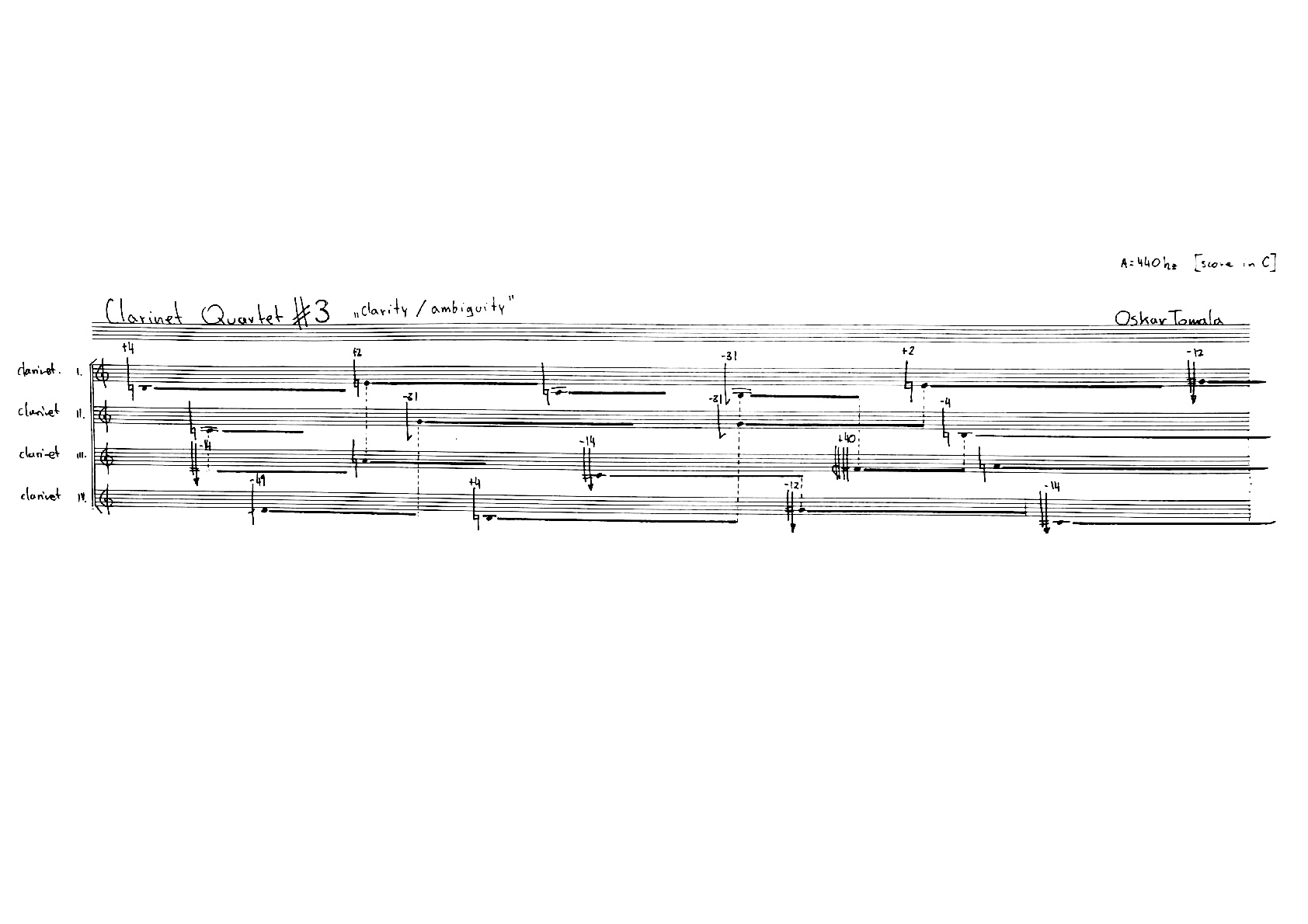“4 compositions for Clarinet Quartet in Jast Intonation”
Clarinet Quartet #1 ‘series’

[PL]
Głównym konceptem dla powstania tej kompozycji było zbudowanie palety dźwięków w oparciu o wysokie składowe serii harmonicznej (w zakresie pomiędzy 18° - 54°) opartej o bardzo niską częstotliwość fundamentalną f=10hz.
Z 13stu dźwięków powstał „klasterowy” akord (mother chord), z którego ujmując następnie dźwięki budowałem progresję utworu. Z zrekonstruowanych fragmentów akordu powstała początkowo szkieletowa forma, następnie rozwijana w technice „hoketusowej”.
[ENG]
The main concept for the creation of this composition was to build a palette of sounds based on the high partials of the harmonic series (in the range between 18° - 54°) based on a very low fundamental frequency f=10hz.
From the 13 sounds a “cluster” chord (mother chord) was created, from which by subjugating the sounds I then built the progression of the piece. From the reconstructed chord fragments, a skeletal form was initially created, then developed in the “hoketus” technique.
~
Clarinet Quartet #2 ‘cluster’s a reference to proximity’
score [in C] excerpt :
![]()
[PL]
Druga z czterech powstałych kompozycji na kwartet klarnetowy porusza intrygujące mnie zjawisko bardzo bliskich współbrzmień (sekundowych). W tym przykładzie głównie opierałem się o sytem 7-limit Just Intonation.
Stąd tytuł utworu mówiący o bliskości i w pewien sposób obrazujący fizyczną bliskość w ujęciu muzycznym.
Cisza następująca miedzy kolejnymi akordami wskazuje na „oddalenie”, tym samym podkreślając, że każde kolejne „zbliżenie” jest unikalnie różne od poprzedniego.
[ENG]
The second of four resulting compositions for clarinet quartet addresses the phenomenon of very close (second) consonances, which intrigues me the most. In this example, I mainly relied on the 7-limit Just Intonation sytem. Hence the title of the piece, which speaks of proximity and in a way illustrates physical proximity in musical terms.
The silence that follows between successive chords indicates “remoteness” thus emphasizing that each successive “proximity” is uniquely different from the previous one.
~
Clarinet Quartet #3 ‘clarity / ambiguity’
score excerpt:
![]()
[PL]
Seria harmoniczna to ciąg parzystych i nieparzystych następujących po sobie liczb naturalnych będącymi wielokrotnością częstotliwości fundamentalnej.
1° 2° 3° 4° 5° 6° 7° 8° 9° itd.
W tej kompozycji obrałem kierunek eksploracji tych dwóch obszarów budujących serię, czyli parzystej: (2°, 4°, itd.) i nieparzystej: (3°, 5°, itd.).
W utworze starałem się zestawić powstałe akordy złożone z „parzystych” harmonicznych z „nieparzystymi” i skomponować utwór w narracji, która wynikała z intuicji i obserwacji.
[ENG]
A harmonic series is a sequence of even and odd consecutive natural numbers that are multiples of the fundamental frequency.
1° 2° 3° 4° 5° 6° 7° 8° 9° etc.
In this composition, I took the direction of exploring these two series-building areas, namely even: (2°, 4°, etc.) and odd: (3°, 5°, etc.).
In the piece, I tried to juxtapose the resulting chords composed of “even” harmonics with “odd” harmonics, and composed the piece in a narrative that came from intuition and observation.
~
Clarinet Quartet #4 ‘shades’
score excerpt:
![]()
[PL]
Ostatnia z powstałych w ramach projektu kompozycji jest wynikiem improwizacji z użyciem komputerowego efektu „pitch-shifter’a”, który w czasie rzeczywistym dodaje do granego dźwięku kolejny interwał.
W tym przypadku forma utworu powstała na bazie dwóch osobnych korespondujących ze sobą głosów instrumentów transponowanych o czysty interwał kwarty (4:3) oraz następnie kwinty (3:2).
[ENG]
The last of the resulting compositions is the result of improvisation using a computer software “pitch-shifter” effect, which adds another interval to the sound being played in real time.
In this case, the form of the piece was created on the basis of two separate corresponding voices of instruments transposed by a pure interval of fourths (4:3) and then fifths (3:2).
~
![]()
project supported under the Culture Scholarship of the City of Gdańsk 2024



